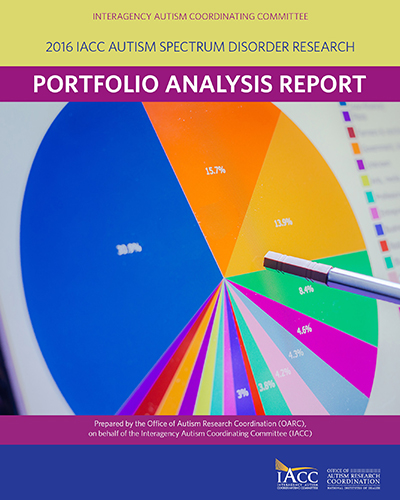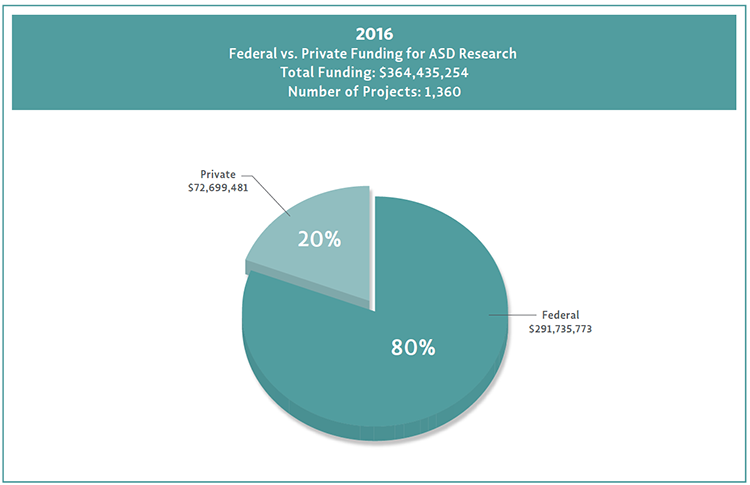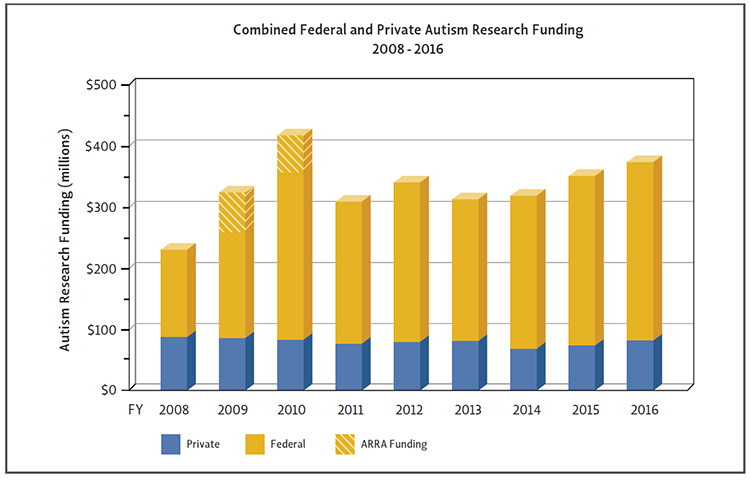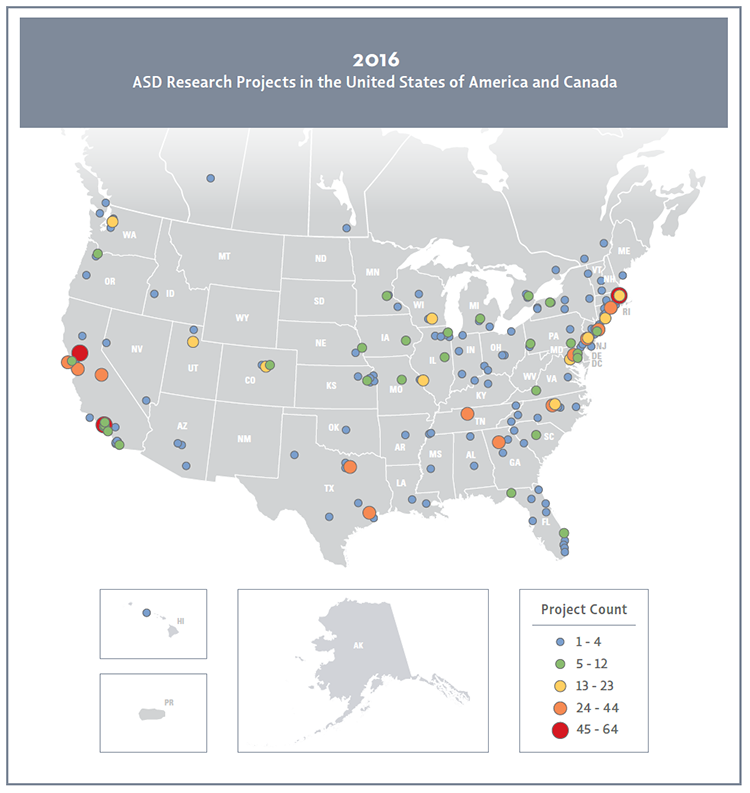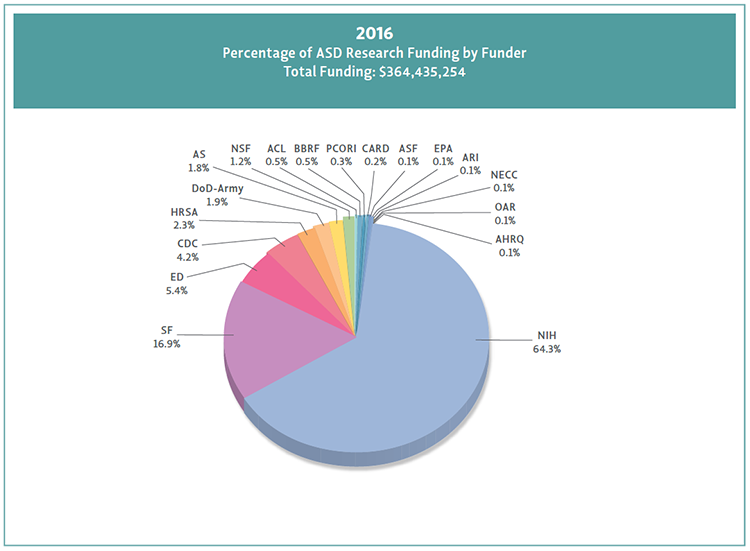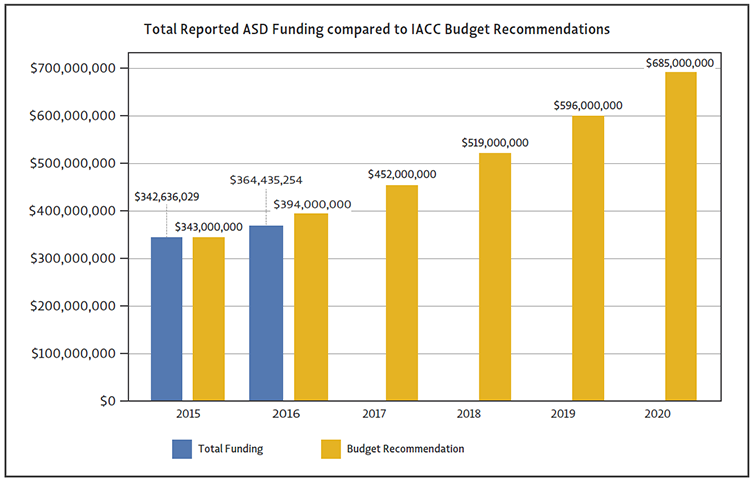Portfolio Analysis Report
IACC Autism Spectrum Disorder Research
2016
ASD Research Funders and Funding in 2016
Who funded ASD research in 2016?
Nine federal agencies and nine private funders provided their autism research funding information for this analysis. These 18 agencies and organizations are listed in Table 1. There were no new agencies or organizations added for the 2016 ASD research portfolio. Some agencies and organizations included in previous years’ analyses did not have projects to report in 2016 or chose not to participate in this year’s analysis. Brief summaries of the mission areas for each agency and organization that contributed to the 2016 Portfolio Analysis can be found in Appendix A of this report.
| Federal Agencies | Private Organizations |
|---|---|
Federal Agencies
|
Private Organizations
|
Table 1. Projects from nine Federal agencies and nine private organizations were included in the 2016 IACC ASD Research Portfolio Analysis Report.
How much ASD research was funded in 2016?
Combined, the estimated federal and private investment in ASD research in 2016 was $364,435,254. The overall funding for autism research increased by $14.1 million from 2015 to 2016. However, the relative proportions contributed by federal and private funders during this period were relatively unchanged from the previous year. In 2016, the federal government provided $291.7 million in ASD research funding and accounted for 80% of overall funding. Private organizations provided $72.7 million in funding, which accounted for 20% of the total funding in 2016 (Figure 4).
Figure 4. In 2016, 80% of ASD research was provided by federal sources, while 20% of funding was provided by private organizations.
What funding trends were observed?
- ASD research funding increased from 2015-2016. In 2015, combined federal and private investment in ASD research was $342.7 million. In 2016, the combined federal and private funding was $364.4 million, an increase of 6.3% over one year (Figure 5).
- Federal investment in ASD research increased 5.1% in 2016 ($291.7 million) from 2015 ($277.6 million).
- The amount of private investment in ASD research reported in 2016 ($72.7 million) was significantly higher, 11.7%, than in 2015 ($65.1 million).
- As stated in previous IACC Portfolio Analysis Reports, the American Recovery and Reinvestment Act (ARRA), which provided an additional $63.9 million in 2009 and $59.9 million in 2010 to support autism research projects, created a temporary increase in total autism research funding levels during those years, resulting in a high of $408.6 million in reported funding in 2010. In 2011, levels significantly decreased in comparison to 2010, but have been slowly rising over recent years. Funding in 2016 was slightly higher than the 2010 non-ARRA funding level and is the highest year of funding since 2010.
Figure 5. This figure illustrates levels of autism research funding from combined federal and private sources during 2008-2016 based on data collected for the IACC Portfolio Analysis of those years.
Where is research being funded in the U.S.?
Figure 6 shows the distribution of autism research projects across the U.S. funded by both federal agencies and private organizations in 2016. The map shows that research is concentrated along the east and west coasts of the U.S. and in major metropolitan areas or areas with large universities in the middle portion of the country.
The U.S. institutions that received the largest amounts of funding are University of California at Davis, Yale University, and University of California at Los Angeles. University of California at Davis has many investigators collaborating on major research initiatives such as the Baby Siblings Consortium, SPARK, and the Childhood Autism Risks from Genetics and Environment (CHARGE) study. It is also the site of the UC Davis Mind Institute and the UC Davis Center for Children’s Environmental Health and Disease Prevention (CCEH). Yale University is similar in that researchers at the institution are collaborating on several large multisite research projects, such as the Simons Simplex Collection (SSC) and the Autism Biomarkers Consortium for Clinical Trials. University of California at Los Angeles has investigators involved in the Autism Intervention Research Network on Behavioral Health (AIR-B network) and the Health Care Transitions Research Network (HCT-RN) for youth and young adults with ASD. Many of the other institutions with significant amounts of funding are involved in large genetic, biological, and environmental research networks in an effort to increase the study size and quality of the research being studied. Table 2 provides some additional information about the institutions and states that had the largest number of projects in 2016.
Figure 6. A map of the U.S. and Canada displaying the distribution of autism-related research projects in 2016 funded by federal agencies and private organizations.
Which U.S. institutions received the most autism research funding in 2016?
| Institution | Funding | Project Count |
|---|---|---|
InstitutionUniversity of California, Davis |
Funding$18,355,969 |
Project Count54 |
InstitutionYale University |
Funding$15,308,925 |
Project Count41 |
InstitutionUniversity of California, Los Angeles |
Funding$15,010,953 |
Project Count44 |
InstitutionNational Institutes of Health - Intramural Research Program |
Funding$13,085,768 |
Project Count12 |
InstitutionUniversity of North Carolina, Chapel Hill |
Funding$10,481,404 |
Project Count34 |
InstitutionNew York Genome Center, Inc. |
Funding$9,824,025 |
Project Count1 |
InstitutionBoston Children’s Hospital |
Funding$9,269,892 |
Project Count22 |
InstitutionStanford University |
Funding$8,620,483 |
Project Count30 |
InstitutionUniversity of California, San Diego |
Funding$8,337,640 |
Project Count28 |
InstitutionMassachusetts Institute of Technology |
Funding$6,809,803 |
Project Count13 |
Which states had the highest levels of funding in 2016?
| Institution | Funding | Project Count |
|---|---|---|
InstitutionCalifornia |
Funding$71,970,228 |
Project Count261 |
InstitutionNew York |
Funding$46,215,102 |
Project Count133 |
InstitutionMassachusetts |
Funding$44,289,321 |
Project Count202 |
InstitutionMaryland |
Funding$33,126,572 |
Project Count62 |
InstitutionPennsylvania |
Funding$18,526,114 |
Project Count77 |
InstitutionNorth Carolina |
Funding$18,014,641 |
Project Count61 |
InstitutionConnecticut |
Funding$16,254,794 |
Project Count46 |
InstitutionGeorgia |
Funding$11,821,168 |
Project Count50 |
InstitutionFlorida |
Funding$9,867,385 |
Project Count32 |
InstitutionTexas |
Funding$9,603,843 |
Project Count40 |
Table 2. Institutions and states with the most ASD-related research funding from federal and private sources in 2016.
Which countries received ASD research funding from U.S. funders?
While majority of the U.S. ASD research funding is awarded to investigators at U.S. institutions, several of the agencies and organizations from which IACC/OARC collects information invest in ASD research internationally. In 2016, 19 countries outside the U.S. received funding for ASD research from agencies and organizations represented in the Portfolio Analysis, with total funding of international projects amounting to $3.6 million and 50 projects were funded. Overall, 1% of total funding went towards institutions outside of the U.S. and 3.7% of all projects were at international institutions. While a few federal agencies funded projects at international institutions, most of the international research was supported by private organizations (Table 3). The countries that received the largest portion of international funding were Canada and the United Kingdom (Table 4).
| Funder |
|---|
FunderNew England Center for Children |
FunderBrain & Behavior Research Foundation |
FunderAutism Speaks |
FunderNational Institutes of Health |
FunderAutism Science Foundation |
FunderSimons Foundation |
FunderDepartment of Defense – Army |
Table 3. List of funders who provided funding for international ASD research in 2016.
| Country | Funding | Project Count |
|---|---|---|
CountryAustralia |
Funding$239,576 |
Project Count4 |
CountryAustria |
Funding$99,730 |
Project Count1 |
CountryBelgium |
Funding$117,500 |
Project Count1 |
CountryCanada |
Funding$1,910,931 |
Project Count20 |
CountryChina |
Funding$5,000 |
Project Count1 |
CountryFrance |
Funding$52,500 |
Project Count2 |
CountryGermany |
Funding$86,948 |
Project Count2 |
CountryIreland |
Funding$0 |
Project Count1 |
CountryIsrael |
Funding$0 |
Project Count1 |
CountryItaly |
Funding$102,436 |
Project Count2 |
CountryNetherlands |
Funding$125,000 |
Project Count1 |
CountryPakistan |
Funding$250,000 |
Project Count1 |
CountryPortugal |
Funding$5,000 |
Project Count1 |
CountrySpain |
Funding$32,158 |
Project Count1 |
CountrySwitzerland |
Funding$0 |
Project Count2 |
CountryTaiwan |
Funding$70,000 |
Project Count1 |
CountryTurkey |
Funding$70,000 |
Project Count1 |
CountryUnited Arab Emirates |
Funding$1,830 |
Project Count1 |
CountryUnited Kingdom |
Funding$414,187 |
Project Count6 |
CountryTotal |
Funding$3,582,796 |
Project Count50 |
Table 4. List of countries that received funding from U.S. federal agencies or private organizations to support ASD research.
How much ASD research funding did each funder provide in 2016?
The 18 agencies and organizations that participated in the 2016 Portfolio Analysis supported 1,360 ASD research projects totaling $364,435,254 (Table 5).
The National Institutes of Health (NIH) was the leading federal (and overall) funder of ASD research in 2016 with a total of $234.4 million, funding 547 projects. NIH funding for autism research increased by $17.7 million from 2015 to 2016. The next largest federal funder was the Department of Education (ED), with $19.6 million, followed by the Centers for Disease Control and Prevention (CDC), with $15.4 million. ED’s research funding decreased by $6.7 million, due to several large, ongoing projects that received large amounts of funding in 2015 but did not receive an increment in 2016. The CDC’s funding stayed relatively the same from 2015 to 2016. As in previous years, the Simons Foundation and Autism Speaks were the largest private funders of ASD research in 2016, with investments of $61.8 million and $6.7 million, respectively. The percentage of overall ASD research funding provided by each agency is depicted in Figure 7.
| Funding Agency/Organization | 2016 Funding | Project Count |
|---|---|---|
Funding Agency/OrganizationNational Institutes of Health (NIH) |
Funding$234,392,406 |
Project Count547* |
Funding Agency/OrganizationSimons Foundation (SF) |
Funding$61,754,800 |
Project Count283 |
Funding Agency/OrganizationDepartment of Education (ED) |
Funding$19,627,374 |
Project Count75 |
Funding Agency/OrganizationCenters for Disease Control & Prevention (CDC) |
Funding$15,390,203 |
Project Count28 |
Funding Agency/OrganizationHealth Resources and Services Administration (HRSA) |
Funding$8,576,199** |
Project Count30 |
Funding Agency/OrganizationDepartment of Defense – Army (DoD-Army) |
Funding$5,533,865 |
Project Count59 |
Funding Agency/OrganizationAutism Speaks (AS) |
Funding$6,745,989 |
Project Count90 |
Funding Agency/OrganizationNational Science Foundation (NSF) |
Funding$4,488,826 |
Project Count44 |
Funding Agency/OrganizationAdministration for Community Living (ACL) |
Funding$1,798,164 |
Project Count7 |
Funding Agency/OrganizationBrain & Behavior Research Foundation (BBRF) |
Funding$1,688,387 |
Project Count56 |
Funding Agency/OrganizationPatient-Centered Outcomes Research Institute (PCORI) |
Funding$539,719 |
Project Count7 |
Funding Agency/OrganizationCenters for Autism and Related Disorders (CARD) |
Funding$690,000 |
Project Count9 |
Funding Agency/OrganizationAutism Science Foundation (ASF) |
Funding$474,072 |
Project Count30 |
Funding Agency/OrganizationEnvironmental Protection Agency (EPA) |
Funding$420,364 |
Project Count1 |
Funding Agency/OrganizationAutism Research Institute (ARI) |
Funding$347,650 |
Project Count8 |
Funding Agency/OrganizationNew England Center for Children (NECC) |
Funding$259,060 |
Project Count64 |
Funding Agency/OrganizationOrganization for Autism Research (OAR) |
Funding$199,803 |
Project Count19 |
Funding Agency/OrganizationAgency for Healthcare Research & Quality (AHRQ) |
Funding$153,695 |
Project Count4 |
Funding Agency/OrganizationGrand Total |
Funding$364,435,254 |
Project Count1,360 |
*The NIH project number shown reflects unique NIH projects. Portions of a project funded by more than one NIH institute (“co-funds”) were combined and only counted as a single project. This approach differs from that used in the NIH RePORT database, where each co-fund portion is counted as a separate project.
**The annual funding amount for some projects reported by HRSA are prorated estimates for the autism-related portion of a larger project.
Table 5. The table lists the total funding and number of projects provided by the 18 federal agencies and private organizations included in the Portfolio Analysis for 2016. Together, the agencies and organizations funded 1,360 projects, representing an overall investment of $364,435,254.
Figure 7. The figure illustrates the percentage of total ASD research funding contributed by the 18 federal agencies and private organizations included in the 2016 portfolio. NIH provided the largest proportion of funding (64.3%), while Simons Foundation provided the largest private investment (16.9%).
Summary of ASD Research Funding in 2016
The recently published 2016-2017 IACC Strategic Plan calls for a doubling of the 2015 ASD research budget to $685 million by 2020. To accomplish this goal, the Committee recommended a nearly 15% annual increase in ASD research funding. Since the 2014-2015 Portfolio Analysis Report, funding for autism research increased from $342.7 million to $364.4 million in 2016, representing a 6.3% increase in funding. While this did not achieve the 2016-2017 IACC Strategic Plan recommended funding amount of $394 million, ASD research did experience a substantial growth in funding for 2016 (Figure 8).
Over the nine-year span from 2008-2016, funding increased by 64%, suggesting a continued overall growth in support of ASD research. However, over the period from 2008 to 2016, ASD funding has grown, while undergoing some fluctuations from one year to the next (Figure 5). Autism research reached a peak in funding (including ARRA funds) in 2010 and then experienced lower, but overall increasing levels of funding over the next few years. In 2016, the ASD research portfolio was funded at the highest level since 2010, but still well below the level that would be required to meet the 2016-2017 IACC Strategic Plan budget recommendation. In future years, funding trends will continue to be monitored to determine progress toward meeting the IACC’s budget recommendation.
Figure 8. The IACC recommends a doubling of the combined federal and private ASD research budget to $685 million by 2020. Based on 2015 and 2016 funding amounts, ASD research investment is lagging behind IACC budget recommendations.


